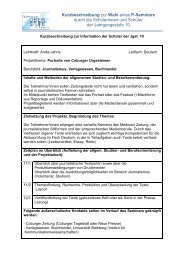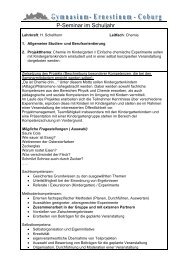Style Sheet: MLA (Modern Language Association) Style Citations
Style Sheet: MLA (Modern Language Association) Style Citations
Style Sheet: MLA (Modern Language Association) Style Citations
Create successful ePaper yourself
Turn your PDF publications into a flip-book with our unique Google optimized e-Paper software.
3<br />
If you quote poetry and you integrate the lines into your text, a slash (/) with a space on either<br />
side is used to separate lines. For example:<br />
In Julius Caesar, Antony begins his famous speech with “Friends, Romans, Countrymen,<br />
lend me your ears; / I come to bury Caesar, not to praise him” (III.ii.75-76).<br />
Long quotations (longer than four typed lines of prose and three typed lines of verse) are<br />
placed in a free-standing block. Quotation marks are omitted. Start the quotation on a new<br />
line, indented one inch (2.54 cm) from the left margin. Your parenthetical citation should<br />
come after the closing punctuation mark. For example:<br />
In his essay “The Right Dream in Miller’s Death of a Salesman”, Lawrence concludes that<br />
Willy’s dreams may not be so wrong after all.<br />
The Works Cited List<br />
Basic rules:<br />
Willy may be deluded but his only delusion is that he thinks men can<br />
be magnificent because they love. This is not the error of a petty man.<br />
Willy is a dreamer. But part of the dream is good. […] Attention must<br />
be paid to Willy Loman because he believes in love, which is only the<br />
extreme form of being well liked. (59)<br />
- Authors’ names are inverted (last name first); if a work has more than one author, invert<br />
only the first author’s name, follow it with a comma, then continue listing the rest of the<br />
authors.<br />
- If you have cited more than one work by the same author, order them alphabetically by<br />
title, and use three hyphens in place of the author’s name.<br />
- If no author is given for a particular work, alphabetize by the title of the piece and use a<br />
shortened version of the title for parenthetical citation.<br />
- Capitalize each word in the titles of articles, books, etc. This rule does not apply to<br />
articles, short prepositions, or conjunctions unless one is the first word of the title or<br />
subtitle.<br />
- Underline or italicize titles of books, journals, magazines, newspapers, and films.<br />
BOOKS<br />
General Format Author#1LastName, FirstName(s), and Author#2FirstName(s) Last Name.<br />
Title of Book. Place of Publication: Publisher, Date of Publication.<br />
Single author Bigsby, Christopher. Arthur Miller: A Critical Study. Cambridge: Cambridge<br />
University Press, 2005.<br />
Multiple authors Booth, Wayne C., Gregory G. Colomb, and Joseph M. Williams. The Craft of<br />
Research. 2nd ed. Chicago: U of Chicago P, 2003.<br />
For works by more than three authors or editors, you may list all as above or<br />
only the first followed by a comma and “et al.”<br />
Translated Work Racine, Jean. Jean Racine’s Phaedra: A Tragedy: A New Verse Translation of<br />
Phèdre. Trans. Edwin Morgan. Manchester, Eng.: Carcanet, 2000.<br />
Multi-volume work Dostoyesvky, Fyodor. The Unpublished Dostoyesky: Diaries and Notebooks<br />
(1860-81). Ed. Carl R. Proffer. Trans. T. S. Berczynski, et al. 3 vols. Ann<br />
Arbor: Ardis, 1973-1976.<br />
No author named The Bible with Sources Revealed: A New View into the Five Books of Moses.<br />
1st ed. Trans. and commentary Richard Elliot Friedmann. San Francisco:<br />
Harper, 2003.

















